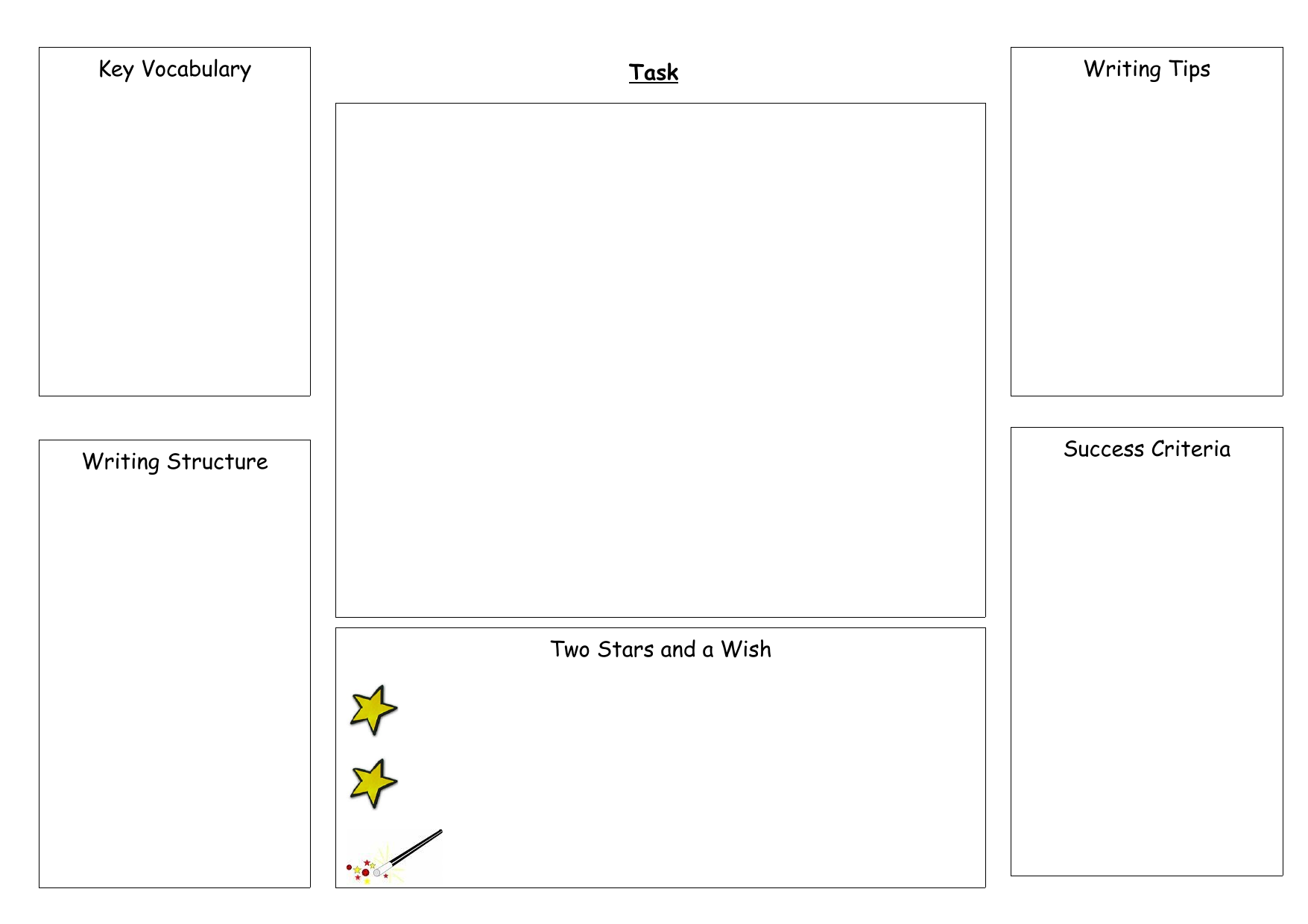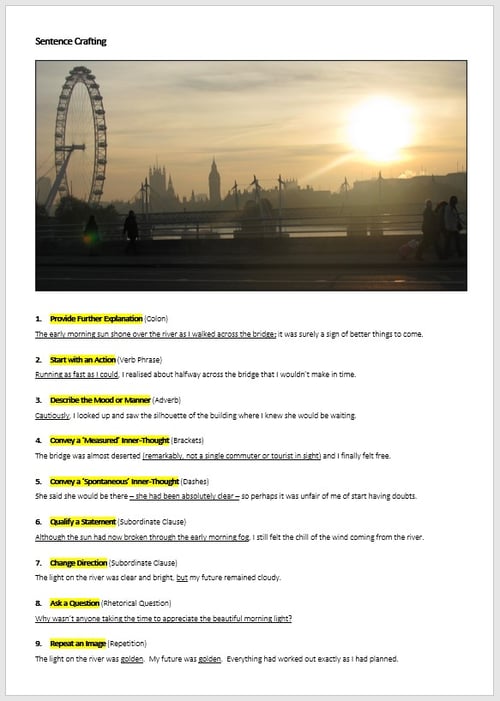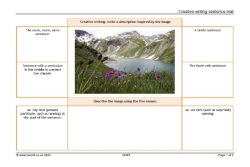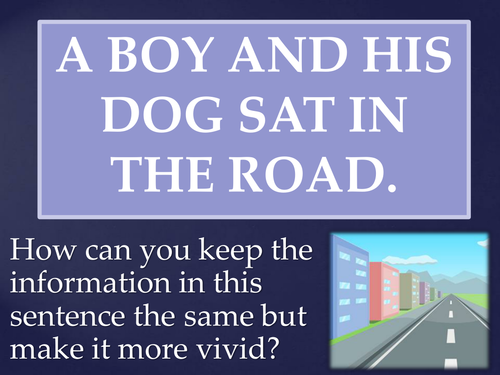- Teach Early Years
- Teach Primary
- Teach Secondary
- Advertise With Us

- New for Schools
- Browse by subject
- Maths & Science
- English & MFL
- Outdoor Learning
- Product Focus
- Resource Guide

Lesson plan: KS4 English – creative writing
- Subject: English
- Date Posted: 09 October 2015
Share this:
Sometimes it’s very hard in English lessons to encourage students to be creative, especially when it comes to writing. Often in class there are a few students to whom this comes naturally; the majority pipe up with the phrase, ‘‘how do I start?’’ whilst some just look scared at the prospect and begin planning their escape.
There is a need to inject spontaneity and fun into developing ideas for writing and to encourage students to take risks. Students need to begin to see writing as an art form, constructing narratives and piecing together ideas until they form rich literary narrative, not sticking to a predetermined layout. They have to do as Dorothy did and take a journey down the yellow brick road, exploring new characters, finding the unexpected, and learning things about themselves they didn’t know before. As teachers we need to open up space for this.
As suggested to me in a conference I recently attended, a good way to start this process is to put an emphasis on reading for change, and to mould students into dynamic readers who share their ideas in constructive ways. There is a lot to be said for high quality talk translating into the same level of writing (Dialogic teaching, Alexander, 2006).
WHY TEACH THIS?
We all know the government changes to the structure of the English GCSE in September 2015 will be the perfect opportunity for departments to look at the use of curriculum time and perhaps consider different approaches to teaching the new style exams. With coursework now gone and exams becoming more rigorous, it seems important that we take more of an exploratory and ‘workshop’ style approach to some elements of the course, allowing students to build confidence in exam technique and feel prepared to tackle questions independently.
STARTER ACTIVITY
Colouring from the inside out.
Here I refer to an article written by my colleague Caroline Saunders in issue 4.4 of Teach Secondary (Beyond the lines); just as she was encouraging art students to draw without using lines, we should encourage English students to do the same when developing ideas for story writing, in other words colouring their narrative from the inside out.
At the start of the lesson have a series of images displayed on the board and printed out in colour for students to look at. In small groups students should draw out meanings and come up with a range of narrative possibilities.
You may want to support this by encouraging each student to come up with one ordinary, one daring and one ridiculous idea for each image, bringing in an element of risk early on. Students should have 5-10 minutes to look at the stimulus. Then ask one student from each group to move around in a carousel, and share ideas. Students should aim to find as many different ideas that link to the images as possible and report back to their original group. Give students roughly three minutes in each group before moving and repeat as many times as you desire. Hear as many of the ideas as possible.
MAIN ACTIVITIES
1. the lion – finding the courage to write.
Teachers may feel at this stage it is appropriate to pick up on one of the ideas from the starter activity and aim to complete a whole class writing piece, using the initial idea as a starting point.
In small groups or as whole class give out 6-8 pieces of A3 paper. Ask students to write a line of the story, inspired by the main idea. Then fold over and pass on. Repeat this 4-8 times. To make it more challenging on each turn display a selection of techniques students should aim to include.
After completion get one student to read out the narrative. Then as a class try to group together ideas from the exercise that fit together, beginning to form the ‘bones’ of the story.
The next step is to flesh out the story; they could do this as a class, in small groups, in pairs or individually. Or write one paragraph as a class and then get the students to explore and play with the narrative, taking it in different directions.
2. The Tin Man – learning to love writing
If you would like to take this path, then get students looking at a range of literature. Ask them to look at summaries and extracts of stories and plays. Here are a few suggestions:
- Metamorphosis (Franz Kafka)
- Mr Stink (David Walliams)
- Great Expectations (Charles Dickens)
- A Monster Calls (Patrick Ness)
- The Famished Road (Ben Okri)
- Enduring Love (Ian McEwan)
- Matilda (Roald Dhal)
- The Ocean at the End of the Lane (Neil Gaiman)
In groups, ask students to explore different themes in the extract they are given. This could range from the obvious to the more subtle depending on ability. Ask students to evaluate how well each of these work.
Next ask students to pick out where the writer has used ordinary, daring and ridiculous ideas within their work. Get them to explore how the writer uses a range of ideas and devices to move the narrative on.
3. The Scarecrow – discovery of imagination
These activities are about getting students to explore their imagination and become more confident writers.
- Give students scenarios or sentence starters that they have to extend into a short narrative. For example ‘The gate swung slowly open…’ One student of mine wrote ‘The gate swung slowly open, for the last time…’, which became an imaginative ‘hook’ into their writing.
- Use ‘story cubes’ with students; get them to roll the dice to determine an imaginative mix of things to include in their writing.
- Have a class box of random objects which students can use as starting points for their work. n Ask students to develop a range of narrative options in response to the activities above, and throw in things that could happen, encouraging them to write in more than one direction.
Ask students to evaluate each other’s work to determine what works best. Ensure they don’t get fixated on one idea and direction; enable them to have a choice. And reassure them that even if it doesn’t work, the process of finding that out is valuable. Once students start thinking in this way about creative writing they will start to “think about the imagination and how it works, of where it might come from, and where it might take you. Then [they’re] in useful trouble.” (Hanif Kureshi).
HOME LEARNING
- Students begin to explore an eclectic mix of art, films and music and generate a stream of consciousness whilst doing this. Students should write down any thoughts/ feelings/ inspiration/ characters that come to mind. They then use these as a basis in the next ‘writing workshop’.
- Students should be given two stock characters (e.g. Miss Havisham and Mr Stink) and they have to write part of a narrative based on their meeting.
- Reading. Students should be constantly challenged to read different types of texts, both fiction and non-fiction. Give them whole texts/ extracts / poetry to read. They could track this by keeping a record in their ‘workshop’ books. Ask students to read a piece ready for discussion in the next workshop.
Get students to reflect back on their work and evaluate the following:
- Have you included daring or ridiculous ideas?
- Have you taken a risk today?
- Did it work? Why? Why not?
- Which ideas did you like the best? Why?
From these teaching strategies students should find themselves walking down roads less travelled and begin to view creative writing in a different light. It should open up their eyes to the idea of literature as art, not so that it takes away the magic but instead (to borrow some words from Grayson Perry, Reith Lectures, 2014) so that “people like the scarecrow and the tin man and the lion might enter the Emerald City of the art world a little smarter, a little braver, and a little fonder.”
ABOUT OUR EXPERT
Caroline Parker is in her fifth year of teaching, having completed her PGCE and Masters degree at the University of Exeter. Caroline is the newly appointed Head of English at Hazelwick School in Crawley.
You may also be interested in...
- Children’s book awards - vote now!
- CPD through Shakespeare
- Reading levels hit nine year high
Subscribe to Our Newsletter
I agree to the Terms & Conditions and Privacy & Cookies Policy.

Recommended for you...

What I learnt at school: Cerys Matthews

Lesson Plan: KS4 History, medieval medicine
Lesson Plan: KS3 Maths – Teach Angles with Clocks
Maths and Science
Lesson Plan: KS3 Maths – Algebraic Manipulation
Browse by Secondary Subject

- Primary Hub
- Art & Design
- Design & Technology
- Health & Wellbeing
- Secondary Hub
- Citizenship
- Primary CPD
- Secondary CPD
- Book Awards
- All Products
- Primary Products
- Secondary Products
- School Trips
- Trip Directory
- Trips by Subject
- Trips by Type
- Trips by Region
- Submit a Trip Venue
Trending stories

Top results

- Teaching Resources
- Creative Writing Organiser For Ks3 And Ks4 English
Creative Writing Organiser for KS3 and KS4 English
Take a look at our Year 8 English worksheets .

Similar resources
- The Boy in the Striped Pyjamas KS3 – Complete scheme of work
- Research project – KS3 English non-fiction lesson plan
- Book cover lesson plan – Making assumptions about texts
- Much Ado About Nothing GCSE – Scheme of work
- KS3 poetry – Identify poetic techniques in song lyrics
Sign up to our newsletter
You'll also receive regular updates from Teachwire with free lesson plans, great new teaching ideas, offers and more. (You can unsubscribe at any time.)
Which sectors are you interested in?
Early Years
Thank you for signing up to our emails!
Explore teaching packs


Why join Teachwire?
Get what you need to become a better teacher with unlimited access to exclusive free classroom resources and expert CPD downloads.
Exclusive classroom resource downloads
Free worksheets and lesson plans
CPD downloads, written by experts
Resource packs to supercharge your planning
Special web-only magazine editions
Educational podcasts & resources
Access to free literacy webinars
Newsletters and offers
Create free account
By signing up you agree to our terms and conditions and privacy policy .
Already have an account? Log in here
Thanks, you're almost there
To help us show you teaching resources, downloads and more you’ll love, complete your profile below.
Welcome to Teachwire!
Set up your account.
Lorem ipsum dolor sit amet consectetur adipisicing elit. Commodi nulla quos inventore beatae tenetur.
I would like to receive regular updates from Teachwire with free lesson plans, great new teaching ideas, offers and more. (You can unsubscribe at any time.)
Log in to Teachwire
Not registered with Teachwire? Sign up for free
Reset Password
Remembered your password? Login here


Sentence Stems for Creative Writing | KS4 Teaching Resource
.jpg?width=50&name=douglas-wise%20(2).jpg)
Click on the link above to access the document with the sentence stems .


Related posts

Punctuation Worksheet for Students

Spelling, Punctuation and Grammar Mixed Practice

Punctuation Guide for Students
Resources you can trust
Creative writing sentence mat

This engaging sentence writing mat is designed to encourage KS3-4 students to write a wider range of sentences in their creative or narrative writing.
With two pictures prompts to inspire their sentence-level experiments (a Christmas market and an Alpine lake), students write a range of different sentences.
Can be used to develop students' fiction writing skills in preparation for GCSE English Language exam tasks, including AQA English Language Paper 1 question 5. It's also perfect for a topical (exam-skills focused!) Christmas lesson at the end of term.
Example sentence tasks from the writing mat:
Describe the image using the five senses:
A simile sentence:
The three-verb sentence:
An -ed verb (such as surprised) opening:
Sentence with a semicolon in the middle to connect two clauses:
An -ing verb (present participle, such as running) at the start of the sentence:
All reviews
Resources you might like.
- International
- Education Jobs
- Schools directory
- Resources Education Jobs Schools directory News Search

Creative writing whole lesson and planning sheet KS3 KS4
Subject: English
Age range: 11-14
Resource type: Lesson (complete)
Last updated
5 November 2018
- Share through email
- Share through twitter
- Share through linkedin
- Share through facebook
- Share through pinterest

Creative Commons "Attribution"
Your rating is required to reflect your happiness.
It's good to leave some feedback.
Something went wrong, please try again later.
conwayjulie
Empty reply does not make any sense for the end user
Report this resource to let us know if it violates our terms and conditions. Our customer service team will review your report and will be in touch.
Not quite what you were looking for? Search by keyword to find the right resource:

IMAGES
VIDEO
COMMENTS
Lessons and activities. Creative and descriptive writing is a great opportunity for students to explore different themes, audiences and purposes as well as demonstrate their understanding of how structure and punctuation can be used to impact a reader. From creative writing prompts to technique booklets and descriptive writing planning mats, we ...
ppt, 4.57 MB. ppt, 4.92 MB. ppt, 9.11 MB. You can find 45 creative writing tasks with picture prompts in these ppts. Unlike technical, academic, and other forms of writing, creative writing fosters imagination and allows students to have a voice. Therefore, it is one of the most effective ways to enhance creativity in the classroom.
Model: now continue writing the story (see guidance), thinking aloud about why you are writing what you are writing. Share: ask the class for suggestions for the next few lines. 'Filter' these suggestions, explaining your own choices where appropriate. Preferably use a scribe (possibly an able pupil) during this part of the lesson.
Mock Writing Task Narrative Prompts. Explore more than 378 "Creative Writing Ks4" resources for teachers, parents and pupils as well as related resources on "Ks4 Creative Writing". Instant access to inspirational lesson plans, schemes of work, assessment, interactive activities, resource packs, PowerPoints, teaching ideas at Twinkl!
Creative writing tips. This helpful checklist or set of tips guides KS3-4 students through some of the fundamental elements of creative writing, including careful planning, as well as how to start and end a story. There is also guidance on how to use flashbacks and 'zooming in' to make their story more engaging for the reader.
20 teaching ideas for creative writing. Writing for purpose and audience: Writing narrative texts. Twenty dynamic ideas to kick-start your students' creative writing. These teaching ideas are great for lessons when your creativity is flagging! The ideas include using a range of prompts (photos, works of art, music, nursery rhymes, memories ...
See Resource A for further guidance and Resource B for a template that may assist you. Discuss the exemplars As part of your preparation for this assessment, you will discuss examples of writing. ... Produce creative writing English 1.4 Credits: 3 Achievement Achievement with Merit Achievement with Excellence Develop and structure ideas in creative
Structure planning sheet Creative writing. Subject: English. Age range: 11-14. Resource type: Worksheet/Activity. File previews. doc, 48.5 KB. Creative writing scheme range of activities to support writing. Tes classic free licence. Report this resource to let us know if it violates our terms and conditions.
A versatile KS4 pack filled with teaching ideas and activities to help students at different stages of creative writing. The pack includes essential sections on sentences, the use of tenses and suggestions for tackling 'problem' areas of writing, from sense based writing to using pictures as prompts. Practical support to inspire your students.
Creative writing is the backbone of English and, while it may not be present in day-to-day analysis, it holds a special place in our hearts here at Beyond. Use our range of GCSE creative writing tasks and lessons to help your students to open up and write creatively, including dedicated lessons on creating characters, developing descriptions ...
Teachers may feel at this stage it is appropriate to pick up on one of the ideas from the starter activity and aim to complete a whole class writing piece, using the initial idea as a starting point. In small groups or as whole class give out 6-8 pieces of A3 paper. Ask students to write a line of the story, inspired by the main idea.
Creative writing. Browse this rich collection of English teaching resources, teaching ideas, templates and creative writing lessons to develop students' descriptive writing, narrative writing and creative writing skills. You'll find compelling picture prompts, supportive word banks and carefully scaffolded resources to engage even the most ...
Tips and strategies for writing a high scoring GCSE creative writing paper: 1. Learn the formats. Know the different formats and conventions of the different GCSE writing tasks. There is a standard layout for a leaflet, for example, where including contact details and a series of bullet points is part of the mark scheme.
English. A simple graphic organiser to arrange and order students' ideas. Download includes PDF and Word doc versions. Find more of David McHale's resources on his TES page Mr Mac's Resources and follow him on Twitter at @mrdmchale. Take a look at our Year 8 English worksheets. SHARE THIS resource.
More. Tes creative writing resources bring the magic of language to life. Our unrivalled range of KS3, KS4 and GCSE rclassroom materials includes: - Creative writing worksheets and activities. - Storytelling projects. Whatever you need, you're sure to find it amongst the thousands of free and premium resources available for you to download and use.
Worksheet. Student activity. A versatile creative writing task which includes a choice of written outcome. The resource guides students to mix and match the various 'elements' and come up with some ideas for a poem, short story or piece of descriptive writing. The elements they are given include a choice of three: titles. settings. times of ...
Sentence Stems for Creative Writing | KS4 Teaching Resource. Click on the link above to access the document with the sentence stems. Cheers -. Doug. [email protected]. , , Sentence stems for students to use and adapt. GCSE English Language Paper 1. Question 5.
Suitable for KS3 and low ability KS4 or as an easy introduction to Creative Writing (CCEA GCSE Unit 4, Task 1) This pack includes notes, areas to complete and prompt work to be completed at length separately. 'Flexing your imagination' exercises - nine tasks to get pupils engaged and start thinking about words, images and uniqueness.
Aimed at lower ability students, this lesson pack encourages students to consider how AO5 and AO6 objectives can be used in creative writing. Students will identify techniques from an example text before applying them to their own work. Twinkl KS3 / KS4 English GCSE English - Full Collection GCSE English Language GCSE Writing Component GCSE ...
To enhance your children's GCSE creative writing skills, allocate time for practice. Plan a structure for creative writing to guide children in organising their thoughts and managing time during the GCSE exam. Apply this structure to various exam questions, such as short stories or describing events.
Resource type. Student activity. This engaging sentence writing mat is designed to encourage KS3-4 students to write a wider range of sentences in their creative or narrative writing. With two pictures prompts to inspire their sentence-level experiments (a Christmas market and an Alpine lake), students write a range of different sentences.
Age range: 11-14. Resource type: Lesson (complete) File previews. pptx, 2.19 MB. docx, 145.83 KB. How to make a scene more vivid and engage a reader through altering adjectives, verbs, nouns and adverbs. Crafting a unique narrative voice. Powerpoint includes: *An image prompt and choice of narratives.